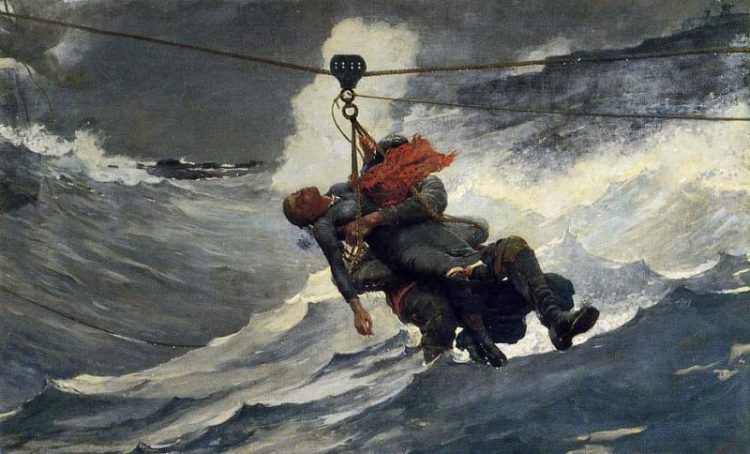
One painting can epitomize the romantic era and simultaneously connect with our own time. A single artistic creation may be able to meld adventure, tragedy and romance, and present all that within a two-foot by four-foot frame.
Look at Winslow Homer’s The Life Line, the centerpiece in an exhibition called “Shipwreck” at the Philadelphia Museum of Art.
Tragedy at sea was a subject of emotional involvement from the time of the ancient Greeks that is, since the original Homer, through the sinking of the Titanic and up to recent sinkings in Italy and the Far East. Our fascination with shipwrecks seems endless, but it was strongest during Winslow Homer’s time (1836-1910), when all intercontinental journeys involved crossing deep, dark and potentially fatal oceans.
Some observers saw the romantic side of shipwrecks, where strong men rescued damsels in distress. The Life Line exploited that thrill of unexpected intimacy between strangers thrown together by disaster.
“Shipwreck” contains 30 works by Homer, complemented by precedents in the rescue genre and by Homer’s preparatory sketches for The Life Line. It’s curated by Kathleen Foster, who possesses a knack for finding drama behind each canvas.
The painter was from New England, closely attuned to the ocean, and he lived for awhile with a lighthouse keeper and his family. He concentrated on sea and shore and struggles with nature, and painted The Life Line in 1884 when he was 48.
Homer here depicted a woman whose ship was overtaken by a storm. She is semi-conscious. Holding the helpless damsel is a courageous hero. Waves crash, winds blow, rocks threaten as a storm looms above them. Originally Homer painted her rescuer’s face but, just before the watercolor was displayed, Homer obscured his face with a billowing scarf.
Homer apparently covered the man’s face to emphasize the loneliness of the woman’s experience and her rescuer thus becomes an impersonal force like the ocean itself. The scarf is like a mask, foretelling the later popularity of masked men, like the Lone Ranger, who came to the rescue of the helpless. (George Washington Trendle, the creator and producer of The Lone Ranger, was born the year that Homer painted The Life Line.)
The woman seems to have barely enough strength to loosely wrap one hand around a rope and cross her ankles. In 1884 there were critics who complained of the sexuality of a wet clinging dress and her exposed legs, although few modern eyes will see the eroticism in the picture.
The showing of The Life Line is, in part, a restoration story. Modern technology revealed that Homer covered over the man’s face and also that he scraped off the man’s hand near the woman’s shoulder. Too much intimacy for the New England artist, perhaps? Or was it just an effort to focus on the woman?
The exhibit also includes Homer’s famous The Wreck of the Iron Crown (1881) and art works that influenced him, most notably The Shipwreck by Claude-Joseph Vernet (1772). Vernet introduced the crucial elements of the shipwreck genre: a rock-bound coast, huge waves, lightning flashes and pathetic victims.
Homer’s biggest innovation was his cropping of the action, focusing on central figures seemingly hanging in space. He also makes the drama seem so lifelike that the viewer wonders what’s going to happen in the next few minutes.
As the exhibit demonstrates, the tradition of helpless women saved by gallant men was popularized in an earlier time period. By 1884, when Homer painted The Life Line the Equal Rights Party had gone so far as to nominate a woman, Belva Ann Lockwood, for president of the United States.
Homer’s work also chronicled the birth of the U.S. Lifesaving Service, which evolved into the Coast Guard. The U.S. government paid “surfmen” to patrol the beaches for trouble. Then they used cannon to shoot lightweight lines attached to a piece of iron that people on distressed ships could grab, establishing a link between the ship and the shore. Homer’s painting portrayed such a lifeline in use. The savior, holding the woman, hangs on to the cord above him as if it were a zip-line. In that decade, deaths at sea dropped impressively.
An attractive catalogue provides an exciting narration of the era and the genre. It includes an especially harrowing 1832 mezzotint by Henry Dawe, My Child! My Child!, showing an apparently drowning mother holding her baby over her head, trying to keep the child above the deadly water.
The reproduction of this tiny work of art demonstrates the value of catalogues: A very small treasure might be overlooked when you walk through a museum. But enlarged on a page, it regains its deserved stature.
In the publication, curator Foster points out the precedents in popular fiction and poetry, such as William Falconer’s “The Shipwreck” and Longfellow’s “The Wreck of the Hesperus”:
At daybreak, on the bleak sea-beach,
A fisherman stood aghast,
To see the form of a maiden fair,
Lashed close to a drifting mast.
We also see monumental urns depicting dramatic scenes of shipwrecks and rescues. The culture was inundated with the subject. Then along came Homer to supply its most vivid expression.
Read other reviews on The Cultural Critic